When French people bake at home, it’s generally a humble affair, and usually they make something as simple as a Yogurt Cake or a fruit tart, made even easier with store-bought pâte brisée (pastry), which is sold in rolls and commonly used in France. It’s not that French people don’t like to bake, it’s just that with so many bakeries nearby, people often leave it to the pros. (And in Paris, kitchens are so compact that rolling out dough is a challenge.) That said, people will tackle a dessert that’s more of a project, although most people in France stick to simple desserts.
In her new book, Gâteau: The Surprisingly Simplicity of French Cakes, Aleksandra Crapanzano, who grew up in Paris (and New York), offers up over 150 French cake recipes, from savory to sweet, each one eminently do-able…wherever you are. Aleksandra really understands French home baking and it’s a thrill to feature her in a guest post, featuring one of the fabulous gâteaux from her book! - David
[Also, I’ll be chatting live with Aleksandra about her book on October 6, with Book Larder. The online chat is free and you can sign up here. If you can’t make the talk, you can see it a few days later on their YouTube channel.]
Gâteau Concorde
by Aleksandra Crapanzano
Who hasn’t listened to someone describe a dessert in deliriously ecstatic terms and longed for a taste? Sadly, only a few of these desserts live up to their storied reputation, perhaps because taste memory is so strongly linked to the memory of place, people, mood, and experience—and so rarely do all of these converge, let alone reconverge in perfect unison. Before getting my hands on the recipe for a Gâteau Concorde, I had a hunch the dessert would disappoint. It was, after all, commissioned to be served on an airplane, albeit the sleek, sexy, luxurious Concorde that for a brief but glorious spell transported lucky jet-setters between New York and Paris in a mere three hours.
How wrong I was! This cake is nothing short of sublime. But allow me to backtrack for a spell…
For over fifty years, my mother, Jane Kramer, was the European Correspondent for The New Yorker. William Shawn, the magazine’s legendary editor from 1952 - 1987, had plucked her out of graduate school after reading a piece of hers in the student newspaper and hired her. Soon she was writing The Letter from Europe for the magazine. Before we moved to Paris, my mother would cross the Atlantic every month or so. It was a grueling schedule until the Concorde arrived on the runway, cutting the flight time by over half. That the Concorde also happened to be a jet of thrilling aerodynamic beauty only added to its chic mystique. Of course, tickets were impossible on a journalist’s budget. But my mother uncovered a loophole, allowing her to buy tickets on the Concorde for the price of a regular 747 ticket.
Jump ahead, and my father and I started to notice that my mother was leaving for the airport with the guilty pleasure of a woman in the throes of a torrid affair and would arrive home in a state of delirious bliss. Her affair, I can happily report, was with the Concorde itself. A woman who’s never paid much heed to cars or really any moving vehicle, she’d fallen head over heels for this speed machine.
What I remember, however, was her description of the cake that was served on board. Created by none other than the legendary pâtissier Gaston Lenôtre, the Gâteau Concorde is, in fact, not a cake but a chocolate riff on a Dacquoise. A Dacquoise is a heavenly, fanciful thing made with discs of nut meringue that sandwich buttercream Chantilly, or fruit, or a combination of all three. It couldn’t be easier to make but offers a serious wow factor. It hails from the town of Dax, in Southwestern France. While researching my new book, Gâteau: The Surprising Simplicity of French Cakes, I uncovered the recipe and am happy to share it with you now.
Lenôtre turned the classic nut meringue into a chocolate dream. In his version, three chocolate meringue discs are layered with a chocolate mousse that is, in fact, a brilliantly rich but ethereal ganache with the consistency of a mousse. It’s decorated with shards of dark chocolate. And that’s it. It’s pure elegance in its simplicity and pure luxury in its richness. And the very attributes that made it fit for air travel are exactly what makes it ideal for dinner parties and celebrations here on the ground. The meringue is made a day, or at least 6 hours in advance, as the ganache can be as well. The decoration requires nothing more than a chocolate bar and a vegetable peeler. I tend to skip this step, however, and dust the Dacquoise first with cocoa powder, then confectioners’ sugar. If berries are in season, I’ll add a few to the top for color.
The Concorde was retired in 2003 after a terrible crash. But the French were not about to retire a dish of culinary brilliance, and so this legendary cake lives on and will no doubt see the arrival of an even faster jet in years to come. If the airline’s smart, they’ll serve this chocolate Dacquoise.
Gâteau Concorde
(Chocolate Meringue and Mousse Cake)
From Gâteau: The Surprising Simplicity of French Cakes
This recipe makes a 3-disc Dacquoise, with each disc being an 8-inch (20cm) circle, and it makes around 6 servings, as it is rich. If you’d like to increase the size, either make the discs bigger or add a fourth. You will need to increase the amounts, of course.
Chocolate Meringue Disks (for a Dacquoise)
6 large egg whites (213 gr), at room temperature
¼ teaspoon cream of tartar (optional)
Pinch of salt
1 cup (200g) granulated sugar
½ cup (50g) almond flour
¼ cup (25g) unsweetened Dutch-processed cocoa
Put two oven racks equidistant from the top and bottom of the oven and preheat the oven to 225°F (107ºC). Line two 18 x 13-inch (45x33cm) baking sheets with sides, with parchment paper. Trace three 8-inch (20cm) circles on the parchment at least 3 inches (5cm) apart. Two circles will be on one baking sheet and the third on the other. Flip the parchment ink side down, then liberally butter the top side.
In a stand mixer fitted with the whip attachment, or using handheld electric beaters, combine the egg whites, cream of tartar (if using), and salt and beat on medium speed until fine bubbles form. Increase the speed to medium-high and whip until soft peaks form. With the mixer running, gradually add the sugar and whip until the meringue is stiff and shiny, but not dry, another 3 minutes.
In a small bowl, whisk together the almond flour and cocoa powder. Sprinkle half of the mixture over the egg whites and, using a rubber spatula, fold to integrate. Repeat with the rest of the cocoa mixture, folding just until combined. Scrape the bottom of the bowl to catch and integrate any stray streaks of almond flour.
Using a piping / pastry bag or a small offset spatula, fill the circles with batter. The trick is to smooth the meringue without pressing down and deflating the eggs, so use a light touch. Use all the batter. If you use a pastry bag, use one with a large enough opening to create a meringue that is about ¾ inch (2cm) in height. I tend to use an offset spatula, as I don’t mind the homemade irregularities.
Bake for 3 to 3 ½ hours, or until the meringues are firm to the touch, but not dry. Turn off the oven, but don’t remove the meringues. Leave them in the closed oven for at least 6 hours and up to 12.
When moving them, use a metal spatula to dislodge them, then move them gently.
Whipped Chocolate, Mousse-Like, Ganache
2 ¼ cups (530ml) heavy cream
10 ounces (280g) bittersweet chocolate, such as Valrhona Caraïbe 66% cacao
Bring ¾ cup (180ml) of the cream to a boil and immediately pour over the chocolate. Allow the chocolate to melt for a minute, then whisk to create a smooth ganache. Set aside to come to room temperature. This shouldn’t take more than about 10 minutes. If it gets too cold, it will start to solidify, which you don’t want. If that happens, warm it up just a tiny bit—just enough that it stirs easily.
In a stand mixer or using handheld electric beaters, whip the remaining 1 ½ cups of the cream until you see soft, but structured, peaks. Stir a third of this whipped cream into the ganache to lighten it, then fold the remaining ganache into the whipped cream with a rubber spatula. Use immediately.
Chocolate Curls (optional)
Making chocolate curls is too time-consuming to do at home. Instead, I like to use a mandoline to cut fine slices of chocolate off a bar or a carrot peeler. These shards are more, shall we say, industrial-chic than delicate, but let’s not get precious about it. Use at least 5 to 7 ounces (150 -200 gr) of dark chocolate if you want to generously cover the entire cake and still allow everyone to sneak a few shards before dinner. Alternatively, dust the cake with cocoa, then confectioners’ sugar.
Assembly
Three Chocolate Meringue Disks (for a Dacquoise)
Lay the chocolate meringue disks on a sheet of parchment. Cover each with a third of the ganache. Then stack them, one on top of the other, on your cake plate. The surface will be ganache. Scatter this with an abundance of chocolate curls or shards. Create a tented dome with aluminum foil over—but not touching—the cake and refrigerate it for at least 6 hours and up to two days. Let it sit at room temperature for about 20-30 minutes to allow the ganache to soften a bit before bringing it to the table.
Get her book, Gâteau: The Surprisingly Simplicity of French Cakes, from your local bookseller or online (Book Larder, Now Serving, Kitchen Arts & Letters, Amazon, Barnes & Noble, and Bookshop.)
Follow Aleksandra on Instagram.
Visit Aleksandra at her website: Aleksandracrapanzano.com
(Photos in this post by Aleksandra Crapanzano)






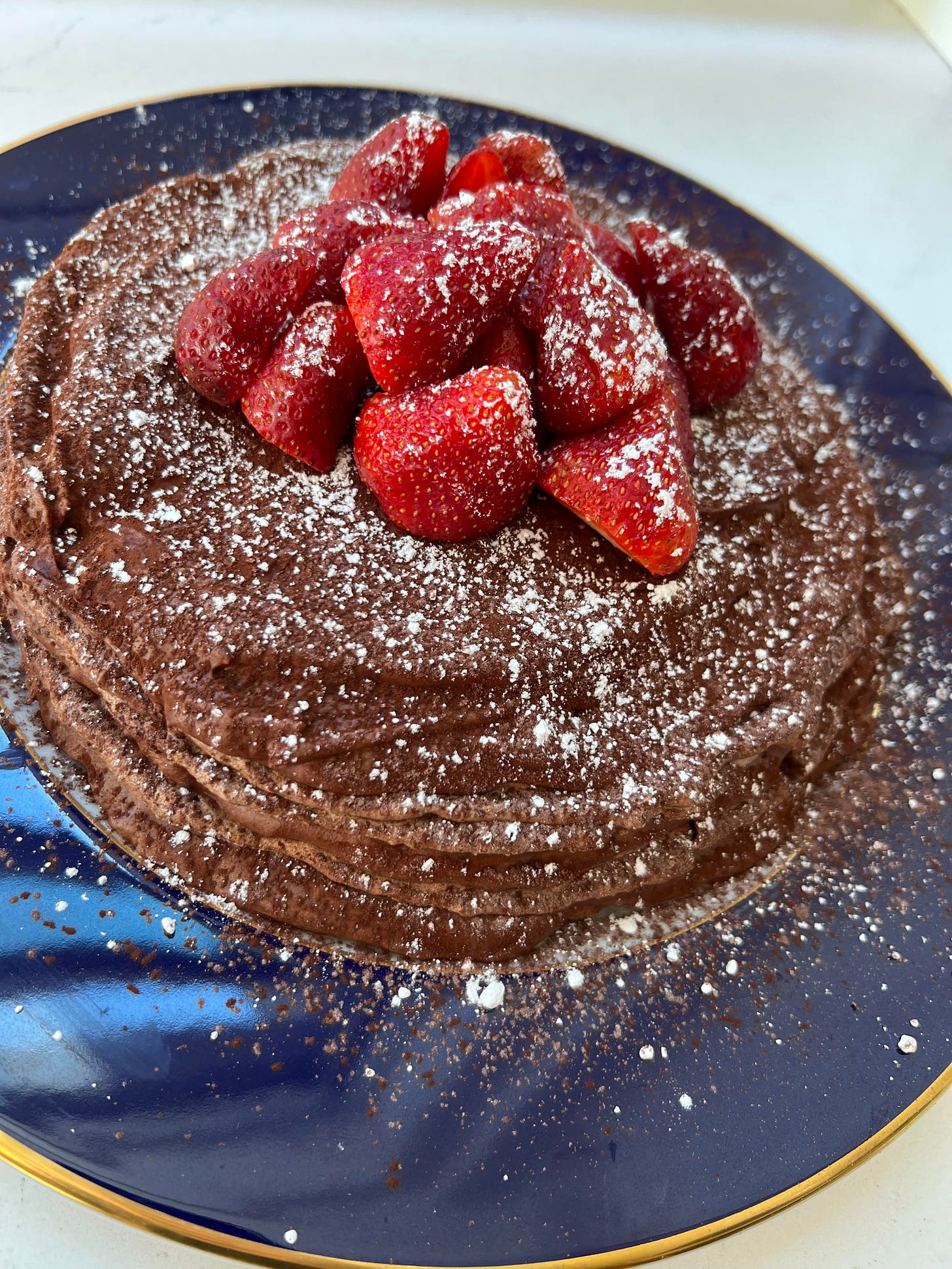
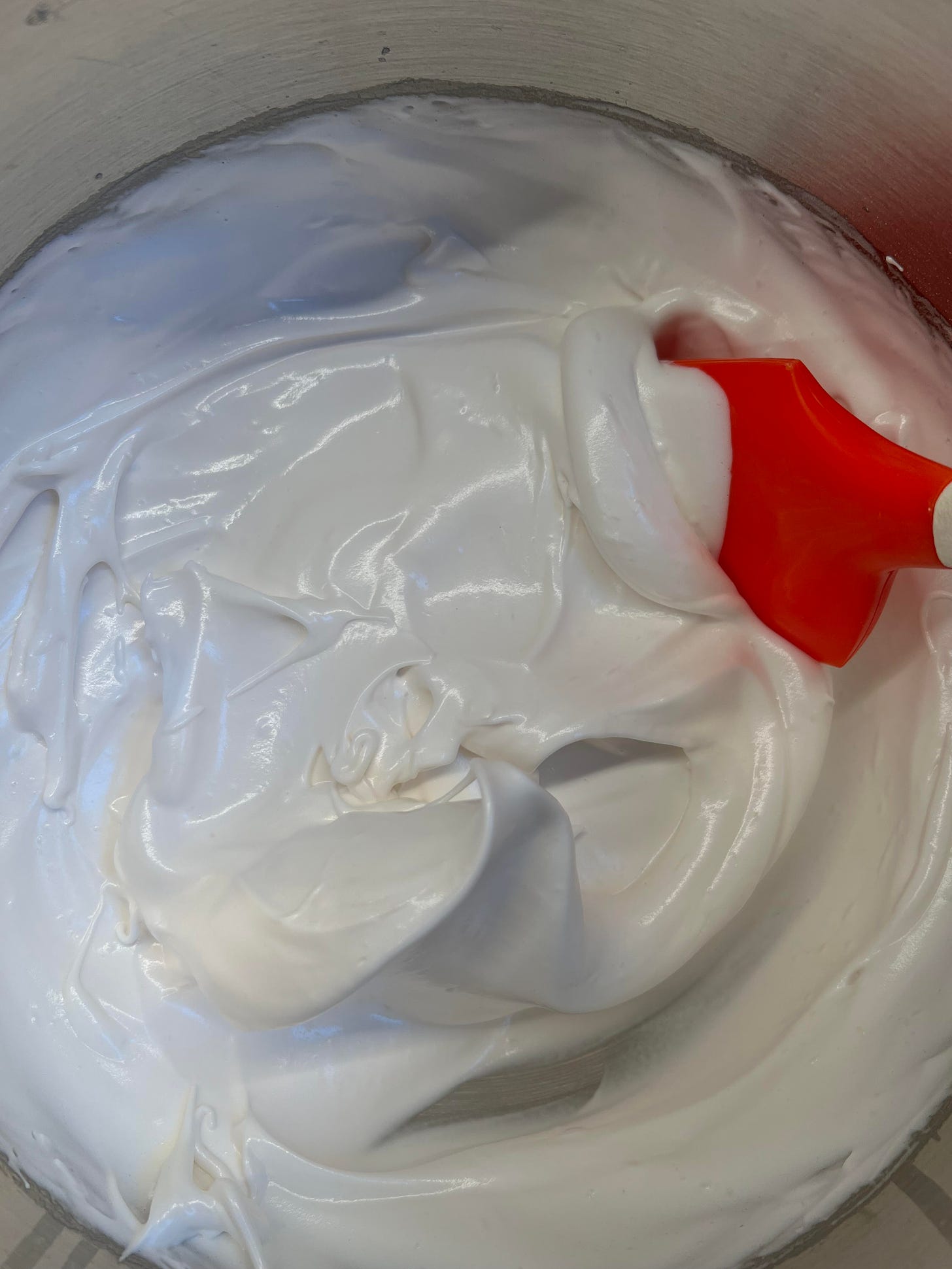
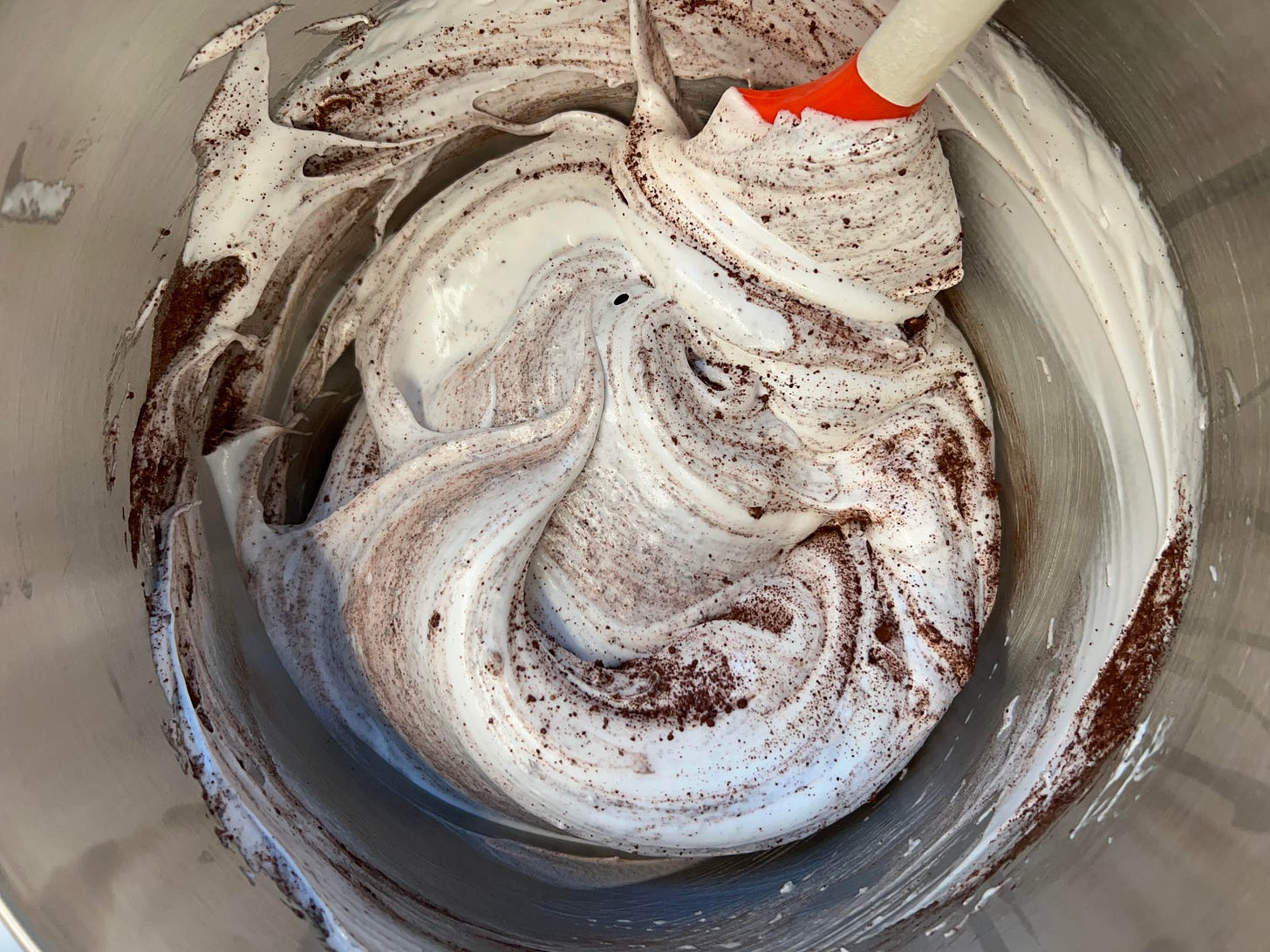
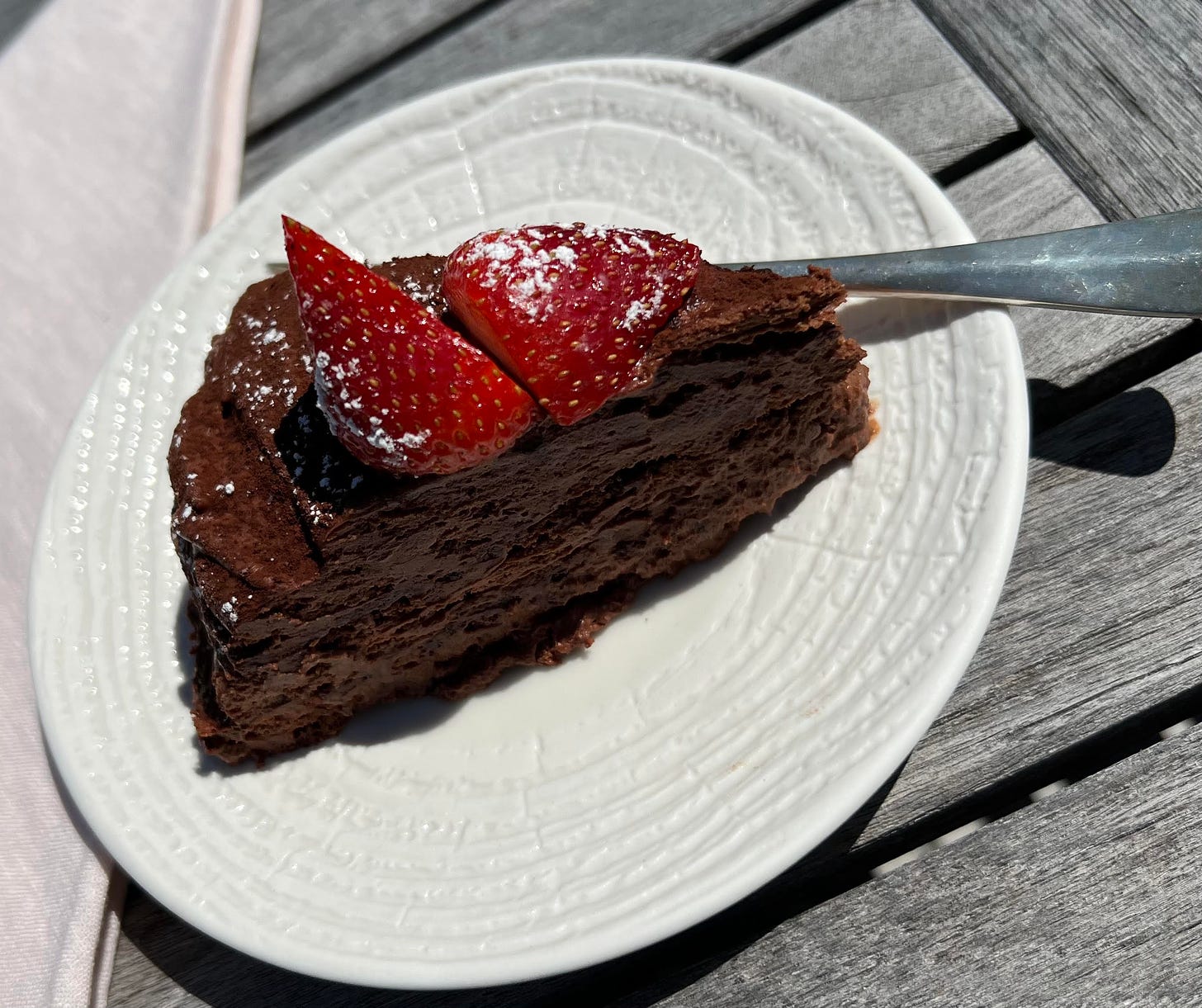
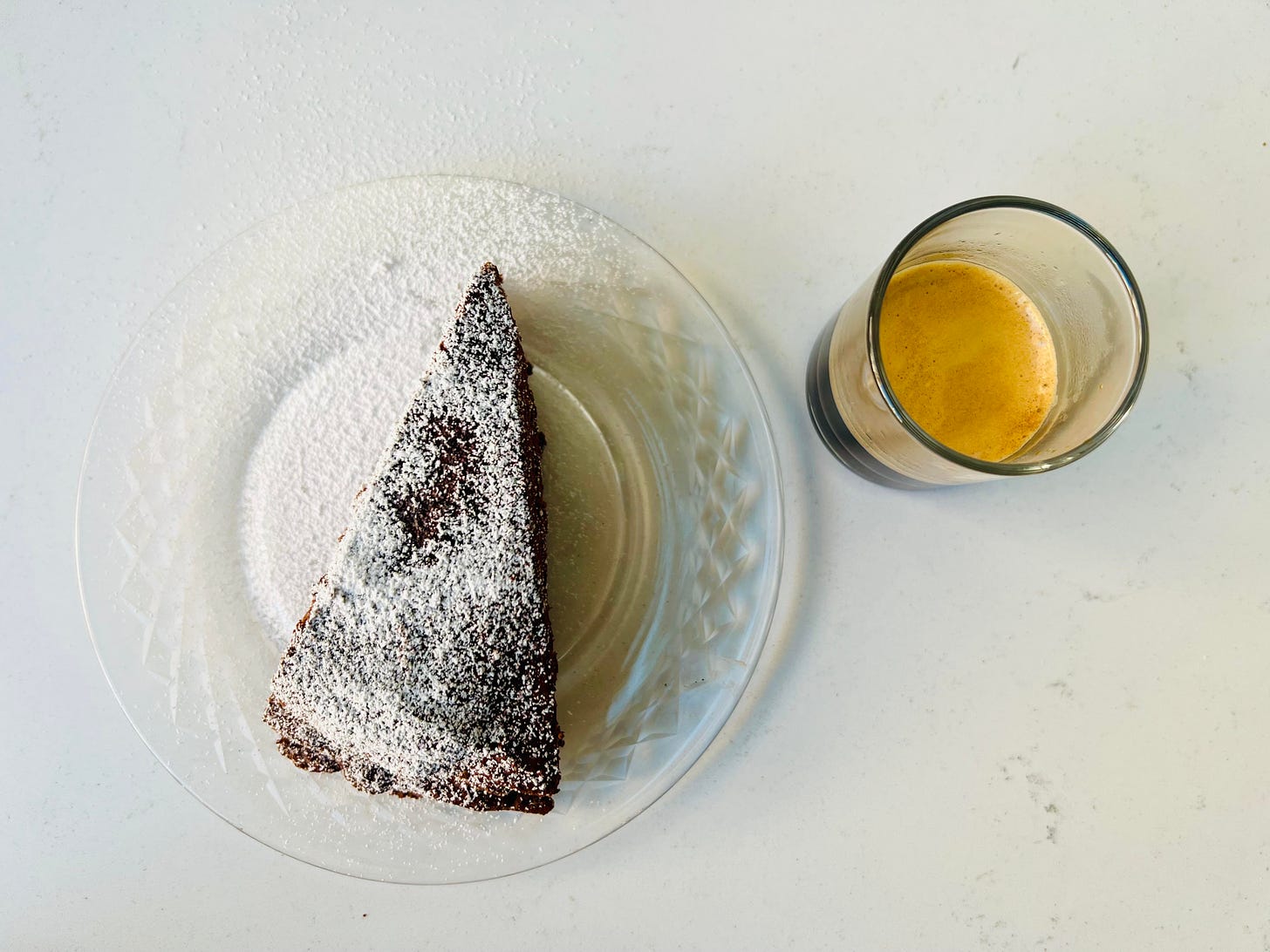


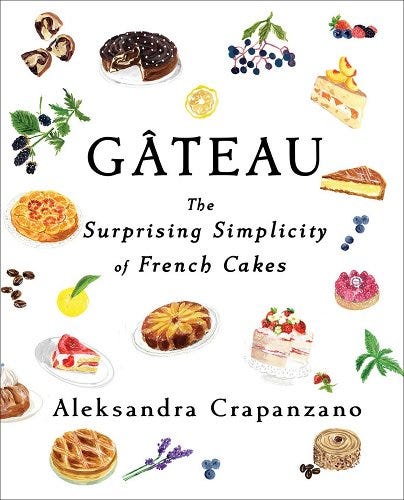

Thank you, David! And thank you all for these lovely comments!
I am a caterer. I found this recipe searching for a dessert we could do for 350 guests at a high-end charity dinner. This was perfect. Not only could we do it ahead of time in stages, but it is gluten free! We made them individual servings by making small circles of meringue and piping in the ganache. And—any meringues that broke or weren’t pretty enough we crumbled and used on top. We stored any broken circles and chunks in an airtight container and used them as decoration on other desserts too. Even pulverized them to use as powder on plates. Great memory of a very successful dinner!